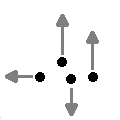|
CGAL 4.8.2 - Kinetic Framework
|
|
CGAL 4.8.2 - Kinetic Framework
|

Kinetic data structures are a way of adding motion to classical geometric data structures. CGAL provides a number of classes to aid implementation of kinetic data structures.
There are three levels at which the user can interact with the package. The user can use an existing kinetic data structure, write a new kinetic data structure, or replace parts of the framework. The first level is covered in this Chapter.
Here we list the main classes and concepts provided by the framework to support implementing kinetic data structures
Kinetic::ActiveObjectsTableCGAL::Kinetic::Active_objects_vector<MovingObject>CGAL::Kinetic::Cartesian<FunctionKernel>Kinetic::FunctionKernelKinetic::InstantaneousKernelCGAL::Kinetic::Default_instantaneous_kernel<ActiveObjectsTable, StaticKernel>Kinetic::Kernel Kinetic::SimulationTraitsKinetic::SimulatorCGAL::Kinetic::Default_simulator<FunctionKernel, EventQueue>Kinetic::KeyKinetic::CertificateKinetic::CertificateGeneratorKinetic::EventQueue Kinetic::FunctionKernel::ConstructFunctionKinetic::FunctionKernel::FunctionKinetic::RootStackKinetic::Simulator::EventKinetic::Simulator::TimeCGAL::Listener<Interface>CGAL::Multi_listener<Interface>CGAL::Ref_counted<T>CGAL::Kinetic::Active_objects_listener_helper<ActiveObjectsTable, KDS>CGAL::Kinetic::Erase_event<ActiveObjectsTable>CGAL::Kinetic::Insert_event<ActiveObjectsTable>CGAL::Kinetic::Qt_moving_points_2<Traits, QtWidget_2>CGAL::Kinetic::Qt_triangulation_2<KineticTriangulation_2, QtWidget_2, QtMovingPoints_2>CGAL::Kinetic::Qt_widget_2<Simulator>CGAL::Kinetic::Regular_triangulation_instantaneous_kernel<ActiveObjectsTable, StaticKernel>CGAL::Kinetic::Simulator_kds_listener<Listener, KDS>CGAL::Kinetic::Simulator_objects_listener<Simulator_listener, KDS>The simulation traits class is simply there for convenience in order to bundle a set of related typedefs and create a few objects. As a resulting, creating your own requires little though, and just copying and changing a few lines. An example is below which sets up to use the CORE Sturm sequences to solve polynomials rather than our own (faster) solvers. It can be found in examples/Kinetic_framework/defining_a_simulation_traits.cpp.
Modules | |
| Main Concepts | |
| Here we list the main concepts provided by the framework to support implementing kinetic data structures. | |
| Main Classes | |
| Here we list the main classes provided by the framework to support implementing kinetic data structures. | |
| Other Classes | |
| Other Concepts | |